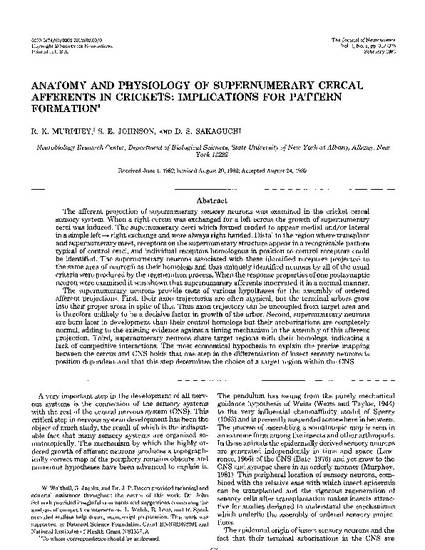
Article
Anatomy and physiology of supernumerary cercal afferents in crickets: implications for pattern formation
The Journal of Neuroscience
(1983)
Abstract
The afferent projection of supernumerary sensory neurons was examined in the cricket cercal sensory system. When a right cercus was exchanged for a left cercus the growth of supernumerary cerci was induced. The supernumerary cerci which formed tended to appear medial and/or lateral in a simple left leads to right exchange and were always right handed. Distal to the region where transplant and supernumerary meet, receptors on the supernumerary structure appear in a recognizable pattern typical of control cerci, and individual receptors homologous in position to control receptors could be identified. The supernumerary neurons associated with these identified receptors projected to the same area of neuropil as their homologs and thus uniquely identified neurons by all of the usual criteria were produced by the regeneration process. When the response properties of one postsynaptic neuron were examined it was shown that supernumerary afferents innervated it in a normal manner. The supernumerary neurons provide tests of various hypotheses for the assembly of ordered afferent projections. First, their axon trajectories are often atypical, but the terminal arbors grow into their proper areas in spite of this. Thus axon trajectory can be uncoupled from target area and is therefore unlikely to be a decisive factor in growth of the arbor. Second, supernumerary neurons are born later in development than their control homologs but their aroborizations are completely normal, adding to the existing evidence against a timing mechanism in the assembly of this afferent projection. Third, supernumerary neurons share target regions with their homologs, indicating a lack of competitive interactions. The most economical hypothesis to explain the precise mapping between the cercus and CNS holds that one step in the differentiation of insect sensory neurons is position dependent and that this step determines the choice of a target region within the CNS.
Disciplines
Publication Date
February, 1983
Publisher Statement
© 1983 by Society for Neuroscience
Citation Information
R. K. Murphey, S. E. Johnson and D. S. Sakaguchi. "Anatomy and physiology of supernumerary cercal afferents in crickets: implications for pattern formation" The Journal of Neuroscience Vol. 3 Iss. 2 (1983) p. 312 - 325 Available at: http://works.bepress.com/donald-sakaguchi/13/
Creative Commons license

This work is licensed under a Creative Commons CC_BY International License.
